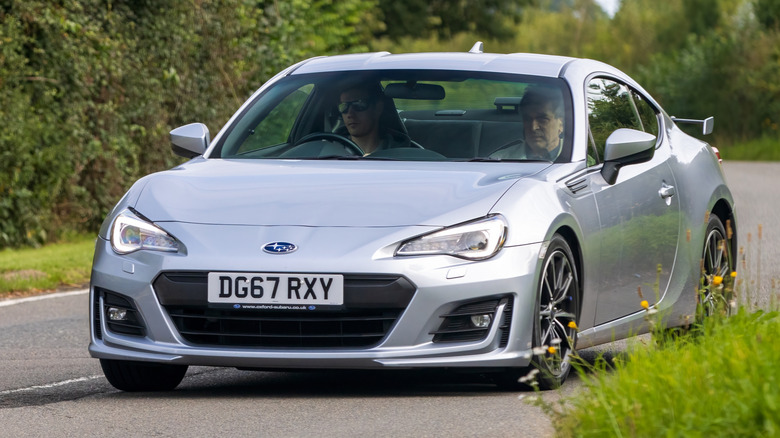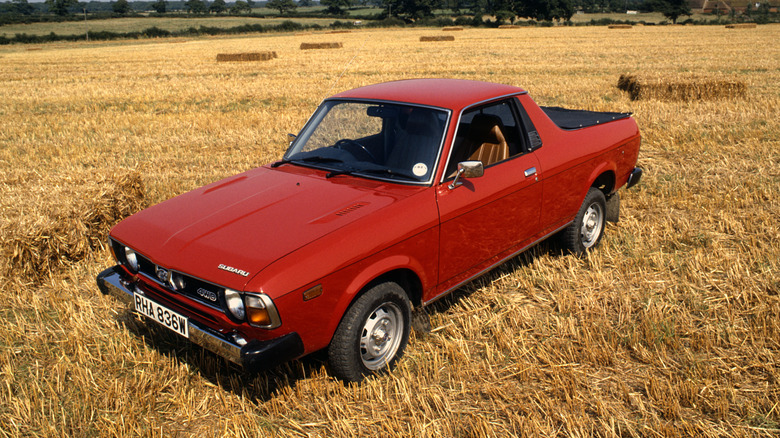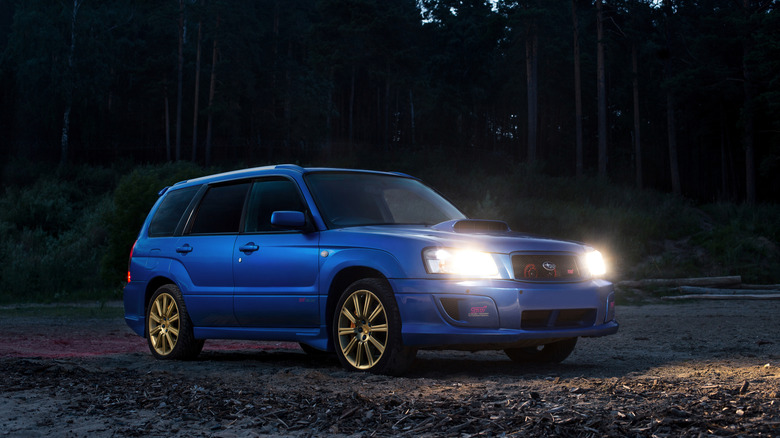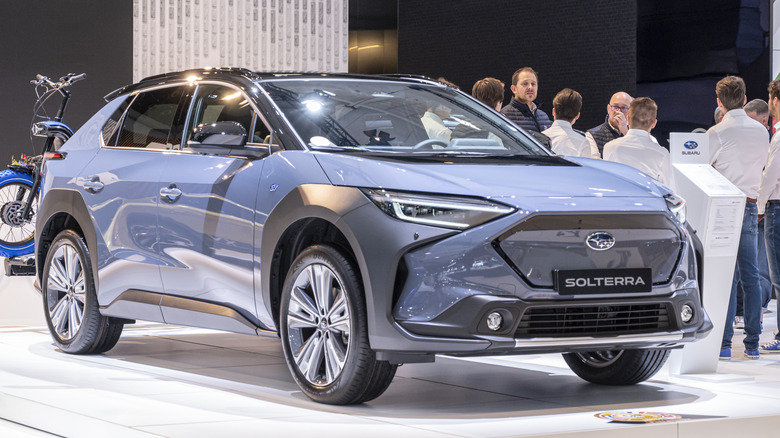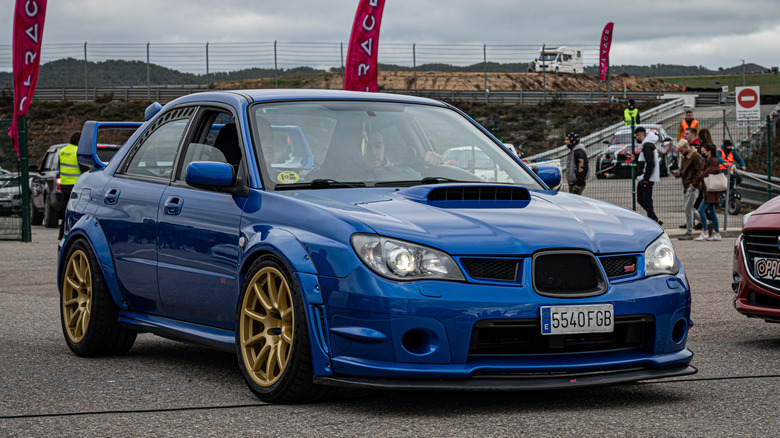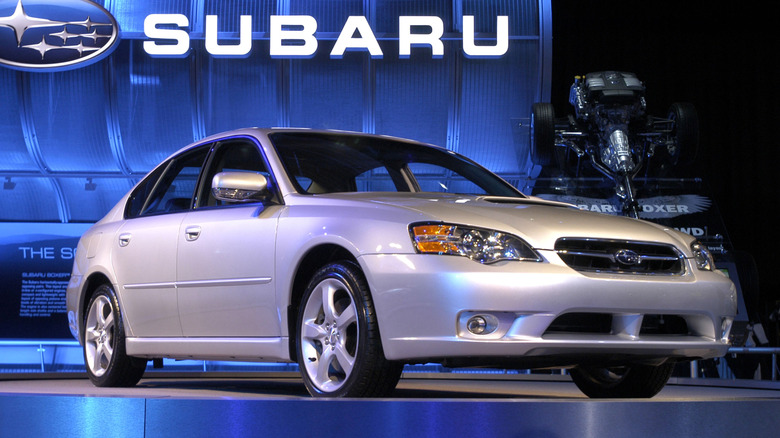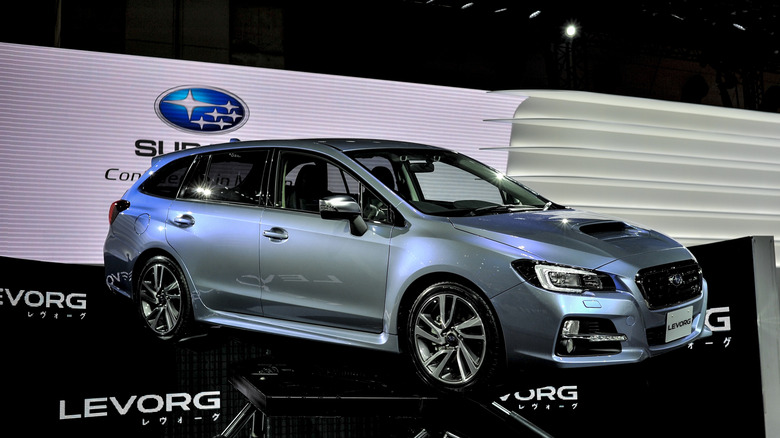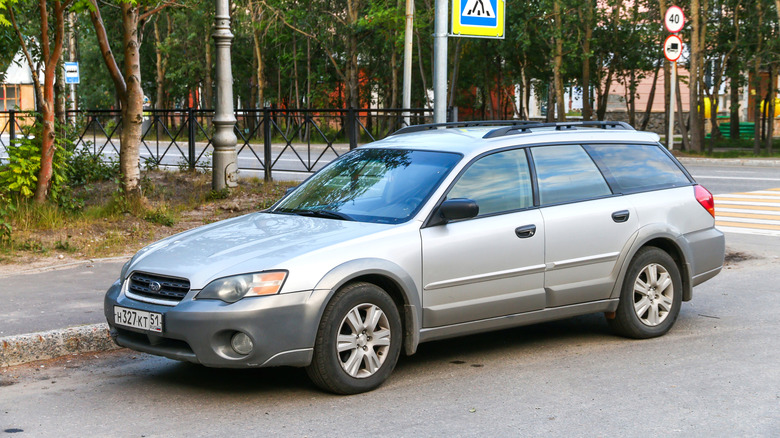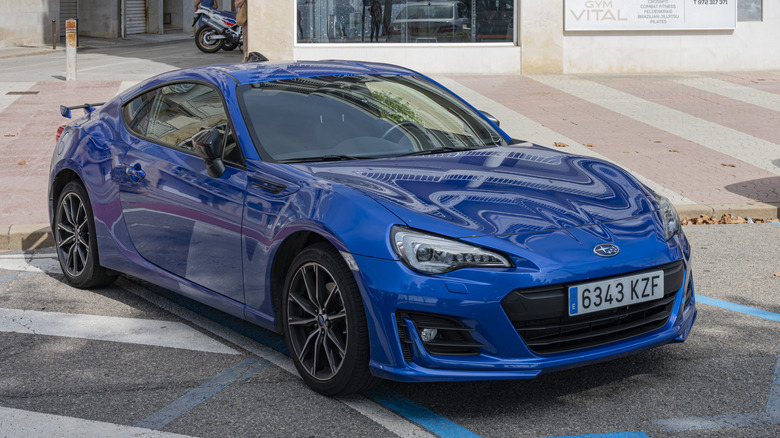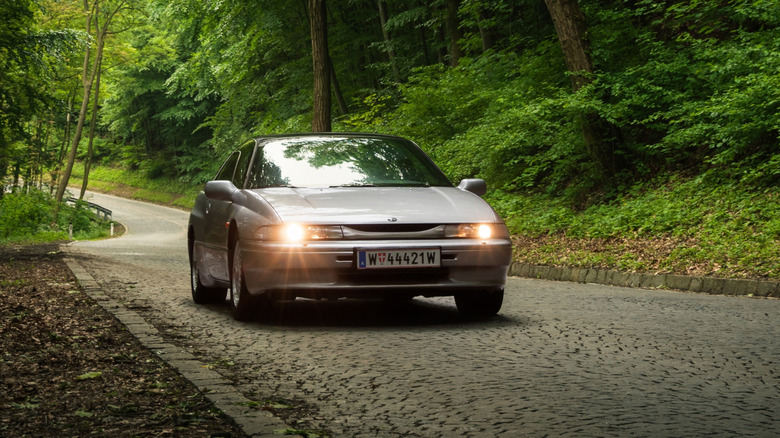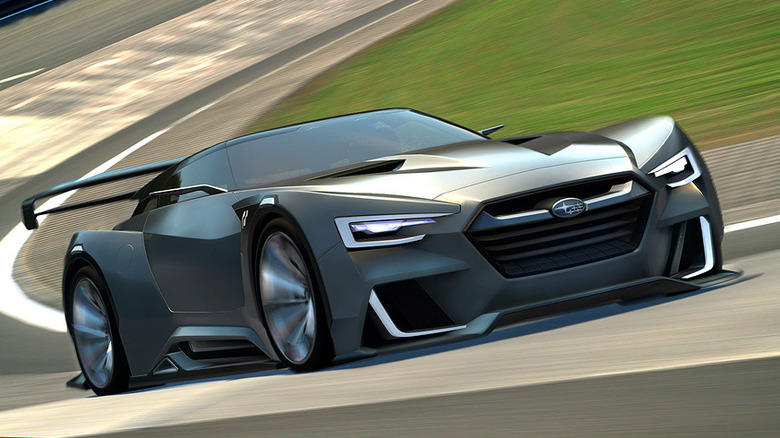10 Of The Best Looking Subaru Models Ever Designed
When you think of aerospace companies that shifted their focus to cars, one that likely immediately comes to mind is Saab. However, there is one other aircraft manufacturer that gave land vehicles a shot and that was actually even more successful: Fuji Heavy Industries.
A renowned Japanese airplane manufacturer and the main supplier of aircraft for the Japanese military during WWII, Fuji Heavy Industries branched out to cars in the 1960s, giving its automotive division a name that would go on to carry a lot of weight in the world of cars: Subaru.
Over the past few decades, Subaru has become known for its penchant for the boxer powertrain, huge amounts of practicality, its insistence on offering AWD as standard on basically everything, and of course, the WRX and WRX STI line of performance cars. Subaru isn't exactly all that well-known for attractive exterior designs, but there are a few models from the automaker's history that buckle that trend.
BRAT
Okay, this one is not exactly beautiful, but it's tough to argue that the Subaru BRAT looks really cool. A tiny pickup truck with a very practical bed, acres of simplicity, and an early form of an AWD system called Bi-Drive. In fact, that's where the BRAT gets its name from, it's an acronym standing for Bi-Drive Recreational All-Terrain Transport.
Based on the Leone, power in the BRAT came from either a 1.6-liter or 1.8-liter boxer four-cylinder engine, both of them boasting a pretty modest power output. This didn't help the BRAT with performance, but then again, it wasn't designed to be an all-out performance car. Of course, in North America, its pickup capabilities were also somewhat hindered.
Subaru installed rear-facing seats inside the completely open bed to avoid paying the chicken tax, as the BRAT wasn't built in the U.S. and thus would have been labeled an imported commercial vehicle otherwise. Today, the BRAT has a cult following, and it's easily one of the coolest Subaru models from the brand's history, certainly from the 80s. Sadly, the BRAT was discontinued in 1987.
Forester (Second Generation)
We all know that the current Subaru Forester is a fairly typical SUV, and actually, the most recent one looks rather good, and it's a pretty good car altogether. However, this wasn't always the case. Being the brand's first SUV, the original Forester doesn't really look like an SUV at all. Much closer to a very boxy lifted wagon.
This was also true of the second-generation Forester, and we think it's easily the best looking from the entire dynasty. It carried on a similar overall design, but it was smoothed out and even boxier, resulting in a much more attractive and definitely distinctive and unique overall design. This Forester also had the grunt to back up the style.
The best version that North America got was the 2.5 XT that put out 230 hp from a 2.5-liter turbocharged boxer four, and you could pair it up to a five-speed manual transmission. The Forester 2.5 XT was a total sleeper, but of course, foreign markets got something even better: the only Forester to offer an STI version, and it's one of the coolest performance SUVs that no one ever talks about.
Solterra
Slight cheating here, as the Solterra is not exclusively Subaru's own design. Toyota and Subaru work together all the time, most notably in the BRZ and GR86 twins, but both companies also share an electric car together. Toyota's version is the horribly named bZ4X, and Subaru's is the much more rationally (though still bizarrely) named Solterra.
Literally translating to "sun earth," the Solterra is the automaker's first production electric car. For the most part, it borrows its overall design from the bZ4X, but there are a few distinctive Solterra touches. This means that it sorts out some of the iffier touches, like the bizarre front-end design.
The Solterra sorts that out with a "grille" and conventional headlights, and it also cleans up the back end as well. The Solterra comes standard with AWD, and while its range could be better, it's a pretty solid EV all things considered. Plus, you can disengage the stability control, and combined with the AWD system, you can do some proper Subaru stuff off-road.
Impreza WRX STI (Hawk Eye)
The Impreza STI and the Mitsubishi Evo have almost always been neck-and-neck, and it really boils down to which one you prefer and if you want your engine mounted vertically or horizontally. However, in the looks department, the Evo almost always wins. There is, however, one exception to that rule.
That would be the Hawk Eye Impreza WRX STI. Every generation of the Impreza STI has a nickname that comes from the shape of its headlights. The Hawk Eye is still based on the second-generation Impreza, but it features Subaru's short-lived triple grille corporate face that we also saw on the extremely ill-fated B9 Tribeca.
Most of the WRX STI lineage looks a little bit fussy, but the Hawk Eye is undoubtedly the cleanest of them all. Super clean sedan lines, wide hips, an attractive front end, and of course, that spoiler. Less fuss, strictly business, made better if the World Rally Blue Mica exterior color is present. Of course, with 276 hp from a 2.5-liter turbo flat-four, the Hawk Eye was also all business on the move, not just sitting still.
Legacy (BP)
Arriving at the tail end of the 1980s originally, the Legacy was Subaru's first larger sedan intended to sit above the Leone, and eventually the Impreza in the lineup. The original first-generation Legacy had its charm, but ultimately, it didn't really have much in the way of style. It was just a basic looking 90s sedan.
That changed when the BP, or fourth generation Legacy arrived in the early 2000s. Out of the entire Legacy ... um, legacy, this one stands out, widely regarded as one of the most attractive of them all. Clean lines, not too big, great proportions, it was definitely a looker.
This generation of the Legacy also had some fantastic powertrains on offer. You could, for example, have a version of the STI's engine in the Legacy 2.5GT spec.B, which you might be surprised to learn was actually offered in North America, though in very limited numbers. If you were more after smoothness and even sweeter engine notes, this Legacy was also available with Subaru's lesser-known flat-six engine. There was also a practical and good-looking wagon on offer, and, of course, this Legacy also received an Outback version. The latest Legacy is a fantastic car, and it's a shame it's going away.
Levorg
Quite a snappy name, huh? Levorg, as you'd imagine and will probably be happy to hear, is an amalgamation of the words legacy, revolution, and touring, in that order. Most would assume that this is some version of the Legacy designed to pad out the lineup in foreign markets, but they'd be quite wrong.
For one, the Levorg is actually based on the Impreza, and while the Japanese domestic market had to deal with this bizarre name, markets like Australia got a name that should sound a lot more familiar, and a lot more exciting: the WRX Wagon.
The WRX Wagon left the American market decades ago, but it's still going strong in RHD markets like Japan and Australia, and even some LHD ones. It's an attractive thing, with sharp lines and fantastic proportions that remind us Subaru is quite good at station wagons. As good-looking as it may be, sadly, it's slightly let down by only offering a CVT, regardless of generation or powertrain. Still, it looks so good, and it does all the things you'd expect a wagon to do, like carrying lots of people and belongings exceptionally well.
Outback (Third Generation)
If you don't associate Subaru with the WRX STI lineage, then you probably associate it with this car. The Outback was at the forefront of the lifted wagon craze that started in the 90s, and even though it wasn't a direct competitor to the original Audi Allroad, it had a leg up on the Allroad: it didn't break all the time.
From its inception, the Outback has been based on the Legacy station wagon. To that, Subaru adds higher ground clearance, slightly chunkier tires, and some additional plastic body cladding. The end result is a station wagon that can do just about anything. Travel somewhere off the pavement where other wagons might struggle? No problem. Loading it up with lots of stuff and people is also no issue at all.
Being based on the BP Legacy, the Outback also got a bit of a styling advantage, as the Legacy's already fantastic lines continued to look fantastic even with all the additional trinkets and raised ride height. The powertrains were basically the same as the Legacy, including all the requisite turbo flat-fours and that lovely-flat six as well.
BRZ (First Generation)
After a long-time absence of a cheap RWD sports car in the lineup, and especially one that was all about handling and not that much about power, Toyota finally decided to bring it back. This time, it collaborated with Subaru creating the Toyobaru twins. Toyota got the 86, which later became the GR86 and was briefly called the Scion FR-S in North America, and Subaru got the BRZ.
The BRZ is still around, sure, but the current one looks a bit ... strange, it looks like its constantly puffing its cheeks and making a funny face. That's not the case with the original BRZ, which is a very attractive and very purposeful sports car that's just begging to be driven purely based on design alone.
Distinctive sharp lines, a long hood and short rear end, very recognizable light signatures, and a super clean overall look make the first generation BRZ an excellent overall package. Sure, it may only have 200 hp from a naturally aspirated boxer four-cylinder, but the driving experience alone makes it one of the greatest sports cars of the modern era. The good looks are just a bonus.
SVX
In the early 90s, virtually all of the Japanese automakers could sell you a flagship sports car of some kind. Nissan had the 300ZX, Mitsubishi had the GTO, Mazda had the RX-7, and so on. Not wanting to be outdone, Subaru joined in with the SVX in the early 90s.
Also known as the Alcyone SVX in Japan, this was something we hadn't seen before from the Shibuya-based automaker. Sure, the previous XT, which also carried the name Alcyone in Japan, was a sports car with a very distinctive wedge shape, but the SVX was something totally different.
From its very thin front end and slim headlights, to the huge by sports car standards greenhouse area and its Lamborghini Countach or DeLorean style side windows, the rear light bar, and the overall shape of the car, the SVX was pretty alien by early 90s standards.
It certainly stands out among its contemporaries, but in terms of the experience behind the wheel, Subaru missed the mark. While the SVX's competitors were all about dynamics and speed, the SVX was tuned more for comfort. Its 3.3-liter flat-six was no match for the competition in terms of power, and being an automatic definitely didn't help matters.
VIZIV GT
Finally, we have something a little more ... out there. Technically, this is more of an honorable mention as none of us can actually buy this Subaru model in real life, but in Gran Turismo. The VIZIV GT Vision Gran Turismo was Subaru's rendition of the ultimate virtual car, as part of the Vision Gran Turismo project in which automakers create spectacular concept cars for the PlayStation exclusive racer.
Subaru went with one of the most beloved, but also one of the most uncommon automotive segments: the shooting brake. The VIZIV GT borrows a lot of its styling cues from other VIZIV concept cars that, sadly, also never reached production. As well as the shooting brake body, the VIZIV GT also adds a whole catalog of spoilers and splitters, creating one truly showstopping concept car.
Powering the VIZIV GT in the Gran Turismo series is a hybrid setup, pairing a 2.0-liter turbo boxer four-cylinder with three electric motors for a total of 630 hp. This is one Subaru model we won't ever see on the street or at a car show, and that's unfortunate because it's a stunner. Still, at least we can drive it on some of the world's greatest racetracks in Gran Turismo until our heart's content.
